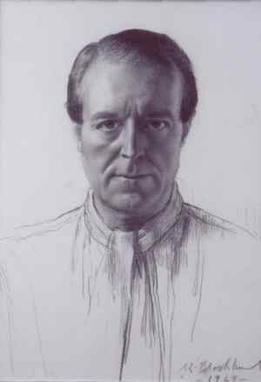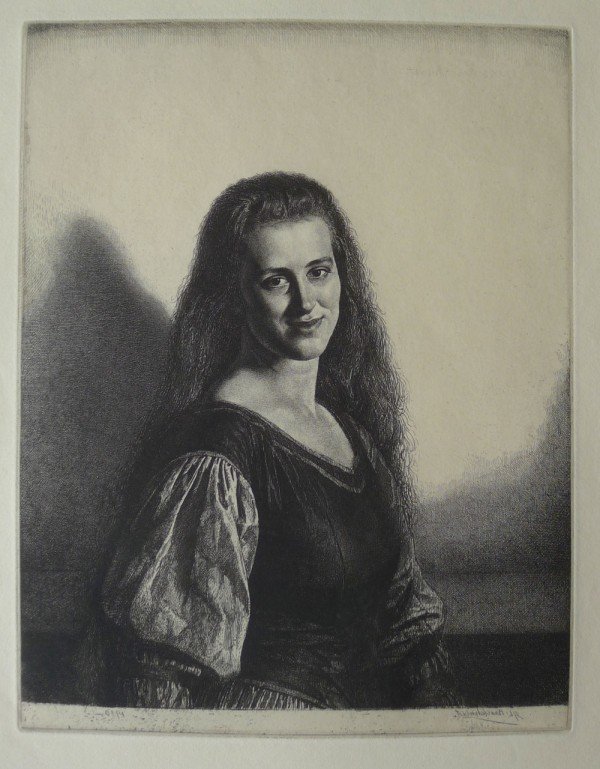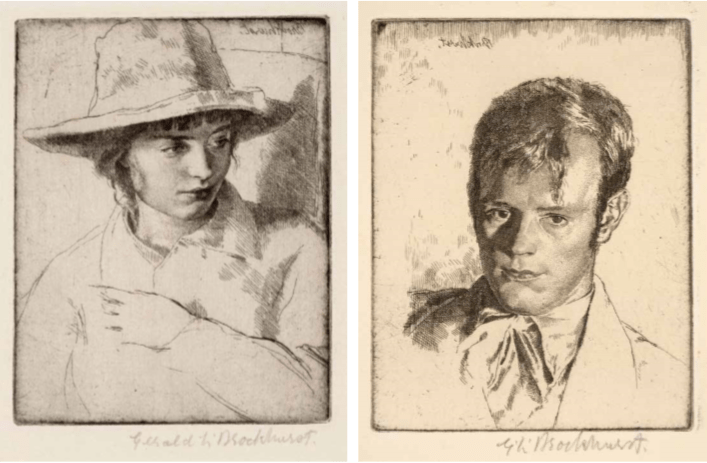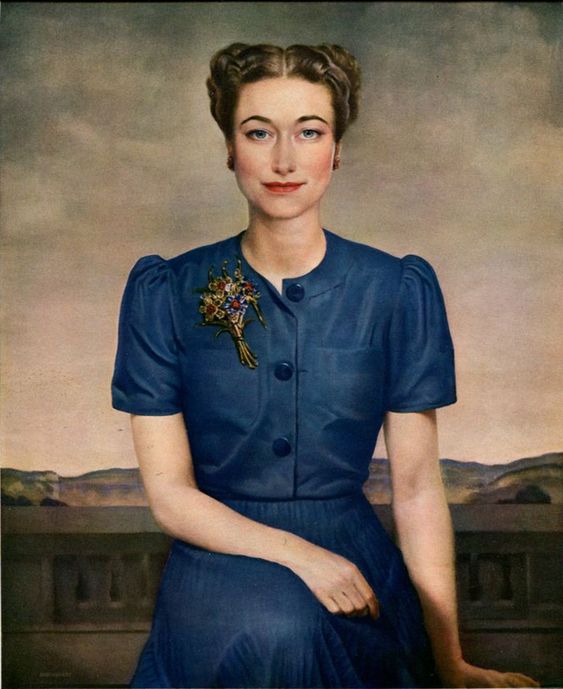To capture beauty with a camera is complicated but with all the aids such as lighting, make-up and Photoshop, photographs of beautiful women are often seen in magazines and newspapers. However, to capture the same life-like beauty in a painting is solely down to the expertise of the artist. As a man, there is something utterly mesmeric when you stand in front of a painting and see before you unadulterated beauty.

I was reminded of this in a comment I received concerning the painting entitled Young Woman Drawing by the eighteenth century French artist Marie-Denise Villers, which I featured in my blog (January 21st 2011). The reader, who confessed to not being a lover of art, commented:
“…while walking through the MET this painting stopped me in my tracks. I love the thoughts that this painting invokes – Who is this woman that is examining me and what does she see? The history of this painting makes it that much intriguing to me and really sets the tone that this painting has nothing to do with the artist weather David or Villers; but more the subject – you. I would pay admission to The MET again just to enjoy this painting one more time. This painting is by far my favorite of the whole museum…”
My blog today is about a man who effortlessly brought beauty to his canvases although such a dedication had a problematic affect on his life. I want you to peruse his many paintings of beautiful women that led to his fame as a great portrait painter. Today I want to introduce you to Gerald Leslie Brockhurst.

Brockhurst was born in the Birmingham suburb of Edgbaston, on October 31st, 1890. He was the youngest of four sons. His father, Arthur, a coal merchant, deserted the family and sought his fortune in America. Gerald attended a number of local schools but found it hard to settle down to school life. He struggled with his writing but excelled in sketching. Problems at school were exacerbated by recurring ear infections he frequently suffered from and which often left him bedridden. As a young boy, he showed a talent for drawing and having an aunt who lived in India, it gave him the opportunity to send her illustrated letters and this really fired-up his interest in art and soon his goal for the future was to become a painter. In 1901, just before his twelfth birthday, he was accepted into the Birmingham School of Art where he remained for five years. He prospered at the academy and the then headmaster of the Birmingham School of Art even announced he had discovered “a young Botticelli”.

During this five-year period, he developed a love for portraiture. Testament to this fact was his self-portrait which he completed in 1905 when he was just fifteen years of age. The portrait is now housed in the Scottish National Portrait Gallery in Edinburgh.
Gerald Brockhurst won many awards at the Birmingham School of Art and later in 1907 he enrolled at the Royal Academy Schools, which was the oldest art school in the country, founded through a personal act of King George III in 1768. In 1912 Brockhurst gained the esteemed Gold Medal for General Excellence and a travelling scholarship.

In 1913 Brockhurst met a young French woman, Anais Melisande Folin. She was an amateur artist and it is thought the two met at the home of Ambrose and Mary McEvoy, with whom she was very close. Anais, besides being an artist, sat for many of his early portraits. During his lifetime, Brockhurst made many portraits of celebrities and royalty, but his main sitters were his family and his wife. The couple married in 1913 and a year later Brockhurst took up his travelling scholarship award and set off with Anais to France and Italy to study the paintings of the old Masters, in particular the work of Leonardo Da Vinci and Piero della Francesco whose stylistic and compositional ideas had a lasting effect on his career.

In 1915, Gerald and Anais moved to Ireland where they remained until 1919. Brockhurst painted a number of pictures on the west coast of Ireland. Whilst in Ireland the couple became friends with some established painters such as Augustus John and it is his influence which can be seen in Brockhurst’s 1916 work entitled Ireland, 1916 which is housed in the Hunterian Art Gallery, University of Glasgow. In this work his wife Anais is depicted in local costume against the Connemara mountains.

It was during those years in Ireland that Brockhurst created many etched and painted portraits of his wife. From those works, we can see that he was truly in love with her and was fascinated by her beauty. His meeting with the Welsh artist, Augustus John proved very fortuitous as he introduced Brockhurst to his circle of friends. In fact, it was Augustus John who persuaded him to stage two major exhibitions of his works at Chelsea’s Chenil Gallery, in 1916 and again in 1919. These were the launchpad to Brockhurst’s artistic career and he and his wife left Ireland and went to live in London in 1920. Once in London he began to enter some of his etchings and drawings to the Royal Academy. In London, Brockhurst became one of the most successful and highly sought-after portrait painters, but he was also a highly skilled draughtsman and etcher.

During the twenties and thirties, there was a voracious market for contemporary etching and Brockhurst quickly mastered the technique publishing his first prints in 1920. In 1921, Brockhurst was elected to membership in the Royal Society of Painter-Etchers and Engravers. One of his first etchings was of his friend and fellow Artist Henry Rushbury. Both had studied at the Birmingham School of Art and when Rushbury left Birmingham to live in London, he first shared a flat with Brockhurst who had already been living in the capital for five years. The etching on the left is entitled Yolande (Mrs Rushbury) and is a portrait of his friend’s wife. Although entitled Yolande, which was a “fancy” name made up by Brockhurst, her name was actually Florence! This etching with its minimal use of lines was described by critics as “a piece of the purest etching in the strictest sense of the word”.
During the next decade Brockhurst established himself as an outstanding and flourishing portrait painter, and also strengthened his reputation as one of the exceptional printmakers of his generation.

By 1930 Brockhurst’s artwork was becoming increasingly popular and his reputation as a portrait artist was in the ascendancy, especially for his portraits of glamorous and beautiful women. Most of his portraiture was depictions in half-length format solely depicting the head, shoulders, and torso of the sitter. One of his most famous portraits, which can be found in Tate Britain, was that of Margaret, Duchess of Argyll. This smaller than life-size portrait(76 x 64cms) by Brockhurst depicts the socialite Margaret Whigham the only child of Helen Mann Hannay and George Hay Whigham, a Scottish millionaire. She would later become the Duchess of Argyll after her second marriage to Ian Douglas Campbell, 11th Duke of Argyll in 1951. When she sat for the painting around 1931, Margaret was nineteen years of age. She was leading a charmed life having been presented at Court in London in 1930 and was known as the debutante of the year. The background of the portrait is comprised of a dark sky and a landscape of mountains and lakes. Margaret was known to be passionately proud of her Scottish heritage, and Brockhurst has reflected this in the way he has painted the scenic backdrop, which evokes the lochs and mountains of Scotland. Margaret faces us, with her face, shoulders, and torso in view. She is wearing a dark dress, and Brockhurst has depicted the golden, floral embroidery in great detail using small brushstrokes. Look at the contrast between her pale, porcelain-like skin with its muted tones with the rest of her face such as her very dark eyes and eyebrows, which are so different in comparison with the whiteness of her face.

Teaching in the Royal Academy Schools, at that time, was undertaken by a system of lectures delivered by Professors and Royal Academician Visitors, and in 1928, when Brockhurst was thirty-eight years old, he was appointed a Visitor to the Royal Academy Schools. It was at this time that he met the sixteen-year-old artist’s life model Kathleen Woodward. Brockhurst was immediately besotted by this youthful and exuberant beauty and she was to become his lifelong model and even though she, his muse, was just sixteen years of age and he was thirty-eight, the two soon became lovers. He renamed her Dorette. which is of Greek origin and means “gift”. This renaming of one’s muse was similar to what his fellow artist and friend, Augustus John had done, when he named his lover and muse, Dorothy McNeil, Dorelia.

His new muse Dorette appeared in many paintings and etchings by Brockhurst but the one people remember the most was his audacious, some would say salacious, while others postulated that it was his greatest print masterpiece – Adolescence, which he completed in 1932. In the depiction we see his mistress, Kathleen Woodward, then nineteen years of age, sitting on a stool in front of her dressing table mirror. From the mirrored reflection we can see that Kathleen is studying her naked body. She seems unhappy with what she sees. It is the personification of teenage angst. It is a study of vulnerability. It is a kind of body dysmorphia in which, although the viewer sees a perfect body, the young woman is disappointed in what the mirror has revealed. The darkly lit depiction adds to the intense scene. It is a depiction which tip-toes along the narrow line separating art and erotica. What we see before us is undoubtedly the artist’s talent in his portrayal of a variety of surfaces, textures, and tones. To some, it is simply a study of beauty to others it is a disturbing, even distasteful depiction but it simply comes down to individual taste.

This brings me back to my opening lines when I talked about being mesmerised by beauty depicted in a painting. I first caught sight of the 1934 painting by Gerald Brockhurst entitled Jeunesse Dorée when I visited the Lady Lever Gallery in Port Sunlight, Merseyside, back in May 2011. In a way the painting was hidden away, hanging on the wall of the narrow mezzanine corridor above the main gallery. The title of the work comes from the French meaning “gilded youth” and the term is often applied to wealthy and fashionable society people. It was painted by Gerald Brockhurst in 1934 and exhibited at that year’s Royal Academy Summer Exhibition. It was subsequently purchased for £1000 by Lord Leverhume, for his Lady Lever Gallery on the very first day of the show.
Take a moment and study this beautiful portrait. It is a half-length portrait with an almost two-dimensional stark and rocky idealised landscape along with an immense sky as the background. There is a lack of depth to the background of this painting, which in a way projects the young girl towards us. This setting was consistent with his many portraits of the 1930’s and 1940’s but which was in contrast to the works of other portraitist who preferred to use realistic three-dimensional settings. He has used sombre colours. The young woman stares straight at us almost as if she is daring us to blink. As you look at her you wonder what is going through her mind. Her eyes are penetrating as if she is looking into your very soul. There is no hint of a smile on her full red lips. Her expression is inscrutable. This however does not detract from her beauty and her captivating sensuality. Her plain-coloured cardigan, echoing the shades of the background, clings tightly to her body. Her full breasts strain against the material and the buttons of the cardigan which hold them captive. It is no wonder that Brockhurst was seduced by her beauty and fell in love with her. Many who have stood before this portrait have also fallen in love with her, having been lost in her enigmatic loveliness. The art critic of the Daily Mail newspaper of the day reported on the painting and its admirers writing:
“…again, I saw people yesterday standing before the picture trying to fathom the secret of those curiously haunting deep-blue eyes…”
Lord Leverhulme lent the picture to the 1934 Liverpool Autumn Exhibition held at Liverpool Walker Art Gallery and this annual exhibition was looked upon as the equivalent of the Royal Academy shows. The curator at the Walker at the time, Charles Carter, wrote in the Liverpool Evening Express that ‘Jeunesse Dorée’ was “a picture of sensuality incarnate”.

Lord Leverhume’s determination to have the painting stemmed from his frustration the year before when he tried to buy Brockhurst’s 1932 etching Dorette, but due to the hesitancy of his Gallery Trustees on whether to fund the proposed acquisition, the sale was lost and it was bought by the Harris Museum and Art Gallery of Preston.

During the thirties the market for prints had collapsed and Brockhurst reverted to painting. In his painting, Portrait of Nancy Woodward, we see a depiction of Dorette’s sister Nancy which Brockhurst completed in the 1930’s. This work is thought to be one of only two portraits that Brockhurst painted of Nancy. What looks like a domestic backdrop to the painting gives the impression of a close relationship he had with the sitter. Nancy strikes a self-confident pose at a time when her sister’s lover was suffering from public censure for his affair with his muse, Kathleen. The 1930’s proved to be a very turbulent time for Brockhurst. On the plus side Brockhurst was earning the highest income of any British portrait painter of the period and in 1937 he was elected to the Royal Academy. However on the down-side, following the publishing of his Adolescence etching a newspaper article appeared exposing his affair with his model Kathleen Woodward. The story created a scandal in England, and his wife Anais was furious and filed for divorce. Gerald Brockhurst was equally vehement with regards his wife’s action and counter-sued.

The adverse publicity in the British press from the divorce procedures which was finally granted to Anais in 1939, combined with the beginning of World War II led to Brockhurst fleeing England with his lover and emigrating to New Jersey where the two married. Brockhurst and Kathleen eventually settled in Franklin Lakes, New Jersey. In New York, Brockhurst’s fame as a portrait artist blossomed and commissions from his loyal patrons flowed in making him both famous and very wealthy.

He was a prolific portraitist who completed in excess of six hundred works, many of rich and famous people such as J Paul Getty, Wallis Simpson, Merle Oberon, and Marlene Dietrich.
Gerald Leslie Brockhurst died in New Jersey on May 4th, 1978 aged 87. His second wife, Kathleen ‘Dorette’ Woodward, died in 1996.

Thank you for featuring this artist – one of my favourite. In fact, I recently wrote and recorded a song called Jeunesse Dorée, inspired by the painting of that name. I live on the Wirral and often go to the Lady Lever to see this wonderful portrait.
Thank you, again.
Johnathan, so glad to see your post on Gerald Brockhurst this morning. I purchased a print of Anais II , after finishing art school more 50 years ago. I was so pleased that I spent the next year at the New York public Library researching Print makers quarterly to find other examples of his work and built a sample collection of his work.
I have been following your posts , since discovering your blog a few years ago. You have a keen eye and love of fine painting that is unmatched and an admiration for real talent and sharing it with others.
This painter’s portraits are enchanting, except for the one of Wallis Simpson which is a lifeless picture and not a very accurate rendering of her features. He must have strongly disliked the woman.
Wonderful article. Informative and fascinating!
Thank you for this. I’m fascinated by Brockhurst. We have a painting of “Dorette” in the Harris gallery at Preston near where I live, and have long been mesmerised by it. Dorette’s Sister is nearby in the Atkinson at Southport.
Thanks for this fascinating article. The portrait of Anais as “Ireland 2016′ has an identical background to the portrait of Aileen (Mrs Thomas) Bodkin from around the same period; it hangs in the National Gallery of Ireland. Thomas Bodkin was shortly to become director of the NGI and was later the first director of the Barber Instiute in Birmingham. Thomas and Aileen were my grandparents.